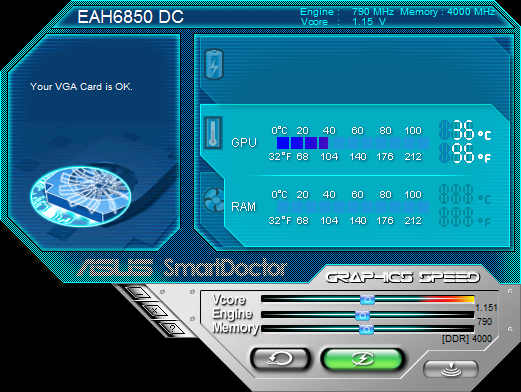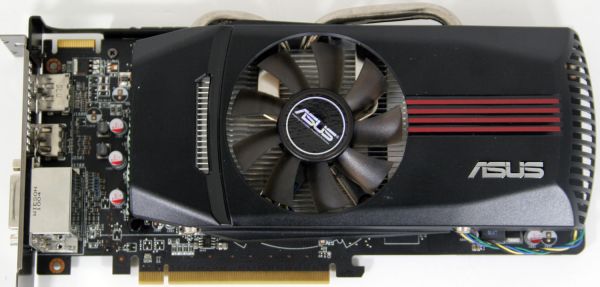AMD Radeon HD 6850 Overclocking Roundup: Asus, XFX, & MSI
by Ryan Smith on November 8, 2010 12:40 AM ESTMeet The Asus EAH6850
Our second card today is Asus’s first Radeon HD 6850, the EAH6850.The EAH6850 is the latest member in Asus’s Voltage Tweak subseries of cards, offering official voltage modification capabilities for overclocking through Asus’s SmartDoctor utility. It’s also the first overclocked card in today’s roundup, featuring a stock speed of 790MHz core and 1000MHz memory, a mere 15MHz over the 6850’s standard clocks. As a result the overclock is a token overclock at best - it’ll edge out stock-clocked cards in testing, but the difference is nothing to write home about.
In terms of design Asus has more or less completely thrown out the 6850 reference design for their own design. Starting with the PCB, Asus has gone with a custom PCB that runs a half-inch longer than the reference PCB, giving the EAH6850 a final length of 9.5”. With this extension Asus has moved the 6pin PCIe power socket to the top of the card, removing the need for additional clearance behind the card and in the process making the power socket much more accessible. Notably there’s a spot for a second power socket, and given the longer length of the card we wouldn’t be surprised if Asus ultimately released a 6870 using this PCB.
Meanwhile the component selection on the card is the usual mix of solid state capacitors and chokes. We haven’t been able to identify the VRM components in use, but we believe Asus is using a different VRM arrangement than on the reference 6850. The card also features a metal spine running down most the length of the card, providing the extra rigidity that a longer card requires and preventing it from significantly flexing.
Attached to the top of the card is the now customary Asus DirectCU cooler, Asus’s highly effective cooler which we have seen on a number of Asus cards in the past. This open-ended cooler uses a pair of aluminum heatpipes attached to a copper baseplate to transfer heat to the card’s aluminum heatsink, which runs roughly 2/3rds the length of the card. Embedded in the middle of the heatsink is the 70mm “dustproof” fan, and a partial shroud keeps airflow directed out the front and the rear of the card. Meanwhile the MOSFETs serving as part of the VRM circuitry have their own heatsink attached through springloaded clips, with airflow coming off of the fan keeping this second heatsink cool.
As is the case with the other partner cards in today’s roundup, Asus has ditched AMD’s 6800 series Eyefinity port configuration in favor of the 5800 series Eyefinity port configuration. This means the card has two DVI ports and the HDMI port along with one full-size DisplayPort, allowing the card to drive up to 5 monitors through a DP hub.

Because this is a Voltage Tweak card, Asus’s software plays an important role here by providing control for the card’s voltage modification capabilities. SmartDoctor has not changed since the last time we’ve seen it, providing a functionally competent but ultimately second-rate overclocking experience, as SmartDoctor lacks meaningful monitoring capabilities. Truth be told, the latest betas of MSI’s Afterburner software are able to program the EAH6850’s VRM controller, meaning there’s no practical reason to use SmartDoctor as the superior Afterburner is available.

As for pack-in items, Asus includes their usual collection for an AMD card: a quick-start manual, driver/utility CD, molex-to-PCIe power adaptor, short CrossFire bridge, a pleather CD binder, and a DVI-to-VGA dongle. Which on that note we had a chance to talk to Asus’s video card product manager last week and asked about the VGA dongle – it turns out that while VGA is largely dead & buried in North America, it’s alive and well in the Asia-Pacific region. Asus is simply packing their cards the same way in all regions, which means they all come with the VGA dongle.
Finally, the EAH6850 comes with Asus’s standard 3 year video card warranty. EAH6850 can be found for around $185, putting it at a $5 premium over AMD’s MSRP.


















93 Comments
View All Comments
doylecc - Tuesday, December 7, 2010 - link
I, too, was unhappy with the inclusion of an OCed Nvidia card in an AMD launch article--it was inserting a "ringer" with an unfair advantage.However, in an OC article, anything goes! This is the place you should have included OCed Nvidia cards for comparison.
The general principle should be:
--Stock cards only in launch articles (since launching cards often have no OCed variants available)
--OCed card reviews can be open to all since the very nature of the cards being reviewed is "non-standard".
We just want to compare apples to apples.
Thanks for a good review.
Masterofevil22 - Saturday, February 19, 2011 - link
Just received my new XFX 6850 with Dual Fans!! First thing I did was to install the newest drivers 11.2 and MSI Afterburner to OC this new supposedly mod friendly hardware. First attempt with stock vcore is %100 stable at 925Mhz GPU and 1150Mhz on the RAM. I can actually get the RAM to 1200Mhz stable, but the GPU has only got a small amount of headroom left at the stock voltage and I CANNOT UNLOCK THE VOLTAGE REGULATOR IN AFTERBURNER!!Any ideas on how to remedy this would be appreciated!!?!!?!!?
Phylyp - Thursday, November 24, 2011 - link
Ryan: Thank you for this review - A week ago, I was going to pick an XFX 6850 based on prior experience with XFX & its brand reputation. Your article highlighted that the Asus 6850 was better aligned to my needs (low noise as my first priority, temperatures as my second, performance as my third).Funnily enough, my card came with two 6-pin connectors, though it shares the same specs as you've listed. It wasn't a problem for me because I had adequate connectors on my PSU for this. I had done adequate research, but Asus's lack of detailed technical info on their website meant that I didn't know of this until I received the card.